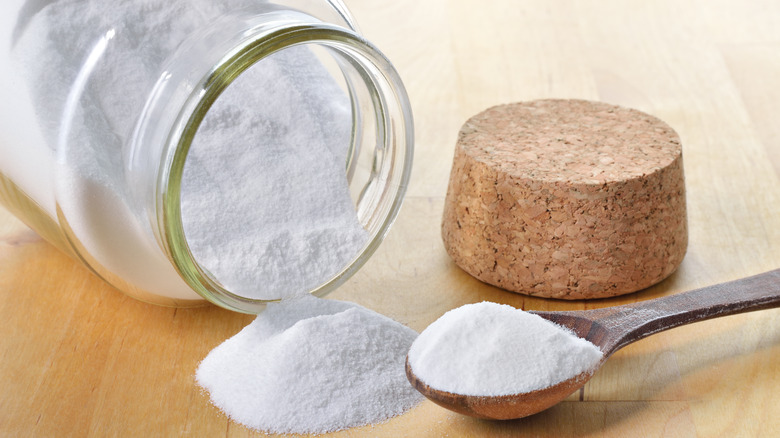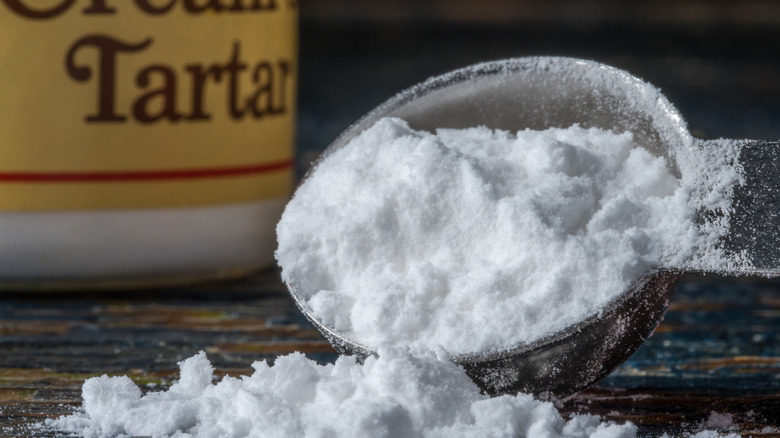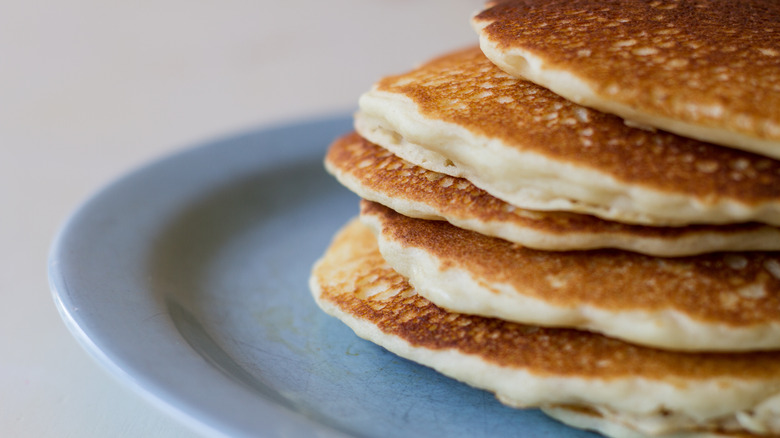The Only Ratio You Need To Substitute Baking Soda And Baking Powder
All of your favorite baked goods, from cookies and cakes to pastries and breads, would be dense, leathery clods if it weren't for the magic of leavening agents – ingredients that cause doughs and batters to rise by filling them with bubbles of gas. For most of human history, the go-to leavening agent was yeast, which is very effective but slow to work with. It takes hours for yeasted foods to rise, and all the way through the 18th century, yeast had to be homemade, using sourdough starter. Fortunately, the mid-1800s brought us two inventions that greatly simplified the leavening process and changed the art of baking forever: Baking soda and baking powder.
Baking soda and baking powder have similar names and appearances, but there is a crucial difference between them. Baking soda, also known as sodium bicarbonate, was introduced to consumers in 1846. It's a type of salt that, when mixed with an acidic ingredient, produces carbon dioxide. Think of the bubbly baking soda and vinegar volcanoes many of us made in elementary school.
Without an acidic ingredient, baking soda doesn't work, and it could be challenging for home cooks to get the pH just right. So, in 1856, chemist Eben Norton Horsford invented baking powder, which is simply baking soda mixed with an acidic powder. This meant that home cooks only needed to add water for their baked goods to rise. It's a brilliant solution and one you can easily replicate at home with a simple ratio in mind. If you ever run out of baking powder, there's no need to rush to the store as long as you still have baking soda and some form of acid in your pantry. To make baking powder at home, all you need to do is mix one part baking soda with two parts of an acidic ingredient.
To make baking powder, just combine baking soda and an acid
A liquid acid such as white vinegar works in a pinch; you wouldn't want to pick something with too strong of a flavor, like rice vinegar or balsamic, but you need to be careful because it can throw off the balance of dry and wet ingredients.
The best acid to use for homemade baking powder is cream of tartar because it also comes in powdered form and won't mess with the texture of your bake. Cream of tartar was actually used all the way back in the 1840s to make an early prototype of baking powder, but at the time, it was too uncommon and expensive for most consumers to access. Today, it's a staple in most pantries, and you should be able to find it at any major grocery store.
The acid used in most commercial baking powder, including Horsford's original formula, is monosodium phosphate, which is made via a reaction of calcium hydroxide and phosphoric acid. You can buy monosodium phosphate online, but it's not as widely available as cream of tartar and is typically more expensive to boot.
Picking the right leavening agent
Substituting baking soda for baking powder is easy to do as long as you have some cream of tartar on hand, but is it really necessary? It depends on what you are baking, as different leavening agents serve different purposes. Generally speaking, you should only use plain baking soda if the recipe also includes an acidic ingredient such as buttermilk, lemon juice, or cocoa powder. If there are no acidic ingredients in a recipe, then you can't use plain baking soda alone, as there will be nothing to activate it. Those are the instances where a quick batch of homemade baking powder comes in clutch.
Some recipes call for a combination of baking soda and baking powder, which might sound strange at first, considering they serve the same function, but it's actually all to do with flavor. When baking soda reacts with an acid, it neutralizes the acidic flavor; therefore, if you make buttermilk pancakes using baking soda alone, you would lose the slightly tangy taste that buttermilk provides. Using a mixture of leaveners preserves some of that tang. It's yet another reason that you can't do a one-to-one swap of baking soda and baking powder. If you're working from a recipe that calls for both, you and you only have sodium bicarbonate, just use the one-to-two ratio and make some baking powder yourself.


